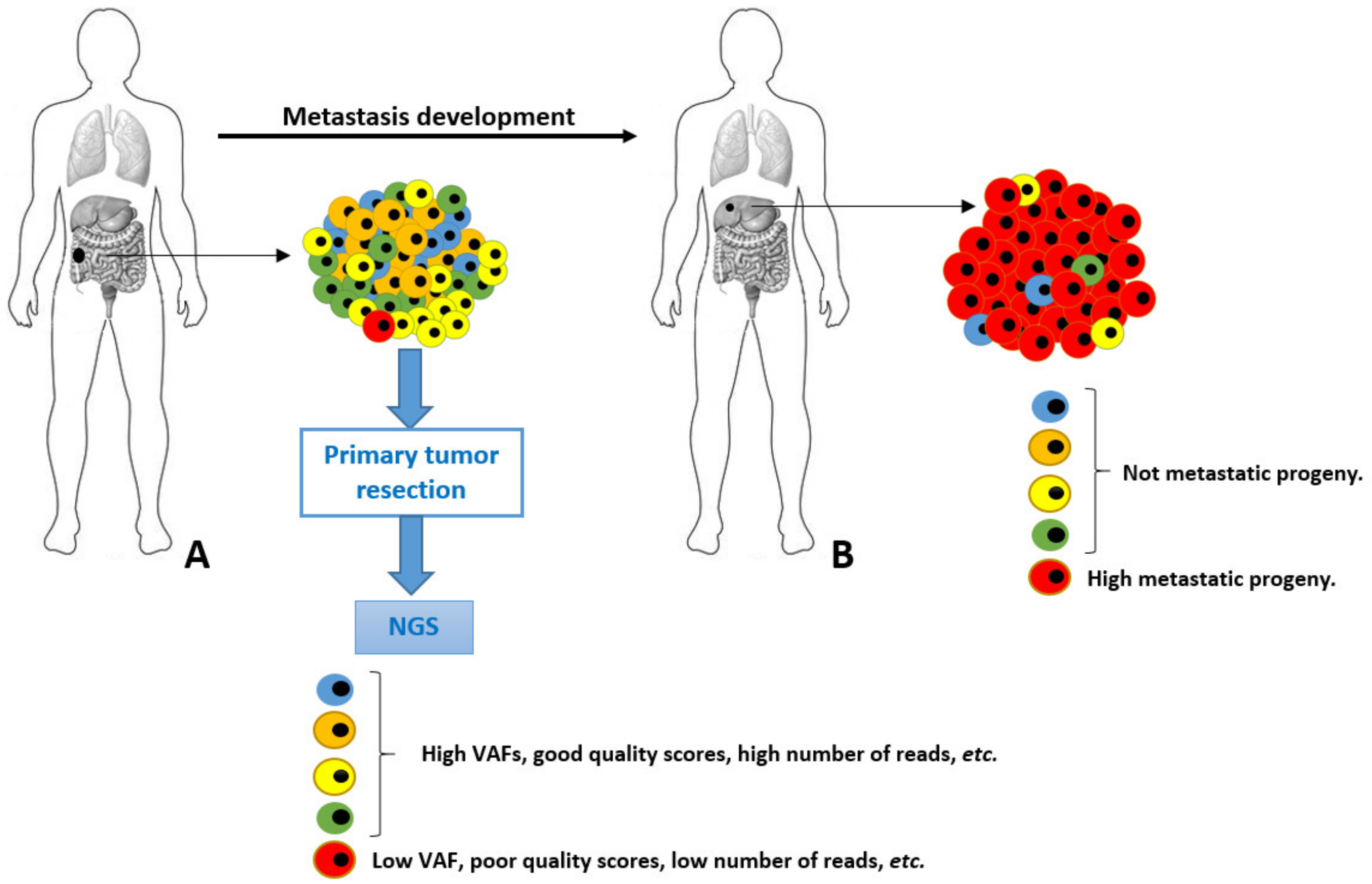The Tumor Dynamism Is the Dark Matter of the NGS Galaxy: How to Understand It?
Author Contributions
Funding
Conflicts of Interest
References
- Von Bubnoff, A. Next-generation sequencing: The race is on. Cell 2008, 132, 721–723. [Google Scholar] [CrossRef] [PubMed] [Green Version]
- Metzker, M.L. Sequencing technologies—The next generation. Nat. Rev. Genet. 2010, 11, 31–46. [Google Scholar] [CrossRef] [PubMed] [Green Version]
- Bris, C.; Goudenege, D.; Desquiret-Dumas, V.; Charif, M.; Colin, E.; Bonneau, D.; Amati-Bonneau, P.; Lenaers, G.; Reynier, P.; Procaccio, V. Bioinformatics Tools and Databases to Assess the Pathogenicity of Mitochondrial DNA Variants in the Field of Next Generation Sequencing. Front. Genet. 2018, 9, 632. [Google Scholar] [CrossRef] [PubMed] [Green Version]
- Crowgey, E.L.; Stabley, D.L.; Chen, C.; Huang, H.; Robbins, K.M.; Polson, S.W.; Sol-Church, K.; Wu, C.H. An integrated approach for analyzing clinical genomic variant data from next-generation sequencing. J. Biomol. Tech. 2015, 26, 19–28. [Google Scholar] [CrossRef] [PubMed] [Green Version]
- Cantacessi, C.; Jex, A.R.; Hall, R.S.; Young, N.D.; Campbell, B.E.; Joachim, A.; Nolan, M.J.; Abubucker, S.; Sternberg, P.W.; Ranganathan, S.; et al. A practical, bioinformatic workflow system for large data sets generated by next-generation sequencing. Nucleic Acids Res. 2010, 38, e171. [Google Scholar] [CrossRef] [PubMed]
- Pinto, C.; Biffoni, M.; Popoli, P.; Marchetti, A.; Marchetti, P.; Martini, N.; Normanno, N. Molecular tests and target therapies in oncology: Recommendations from the Italian workshop. Fut. Oncol. 2021, 17, 3529–3539. [Google Scholar] [CrossRef] [PubMed]
- Sabeti, P.C.; Schaffner, S.F.; Fry, B.; Lohmueller, J.; Varilly, P.; Shamovsky, O.; Palma, A.; Mikkelsen, T.S.; Altshuler, D.; Lander, E.S. Positive natural selection in the human lineage. Science 2006, 312, 1614–1620. [Google Scholar] [CrossRef] [PubMed] [Green Version]
- Harris, E.E.; Meyer, D. The molecular signature of selection underlying human adaptations. Am. J. Phys. Anthropol. 2006, 43, 89–130. [Google Scholar] [CrossRef] [PubMed]
- Ottaiano, A.; Santorsola, M.; Caraglia, M.; Circelli, L.; Gigantino, V.; Botti, G.; Nasti, G. Genetic regressive trajectories in colorectal cancer: A new hallmark of oligo-metastatic disease? Transl. Oncol. 2021, 14, 101131. [Google Scholar] [CrossRef] [PubMed]
- Lin, C.; Liu, X.; Zheng, B.; Ke, R.; Tzeng, C.M. Liquid Biopsy, ctDNA Diagnosis through NGS. Life 2021, 11, 890. [Google Scholar] [CrossRef] [PubMed]
- Heidrich, I.; Abdalla, T.S.A.; Reeh, M.; Pantel, K. Clinical Applications of Circulating Tumor Cells and Circulating Tumor DNA as a Liquid Biopsy Marker in Colorectal Cancer. Cancers 2021, 13, 4500. [Google Scholar] [CrossRef] [PubMed]
- Sakamoto, Y.; Zaha, S.; Suzuki, Y.; Seki, M.; Suzuki, A. Application of long-read sequencing to the detection of structural variants in human cancer genomes. Comput. Struct. Biotechnol. J. 2021, 19, 4207–4216. [Google Scholar] [CrossRef] [PubMed]
- Lin, B.; Hui, J.; Mao, H. Nanopore Technology and Its Applications in Gene Sequencing. Biosensors 2021, 11, 214. [Google Scholar] [CrossRef] [PubMed]
- Alfaro, J.A.; Bohländer, P.; Dai, M.; Filius, M.; Howard, C.J.; van Kooten, X.F.; Ohayon, S.; Pomorski, A.; Schmid, S.; Aksimentiev, A.; et al. The emerging landscape of single-molecule protein sequencing technologies. Nat. Methods 2021, 18, 604–617. [Google Scholar] [CrossRef] [PubMed]

Publisher’s Note: MDPI stays neutral with regard to jurisdictional claims in published maps and institutional affiliations. |
© 2021 by the authors. Licensee MDPI, Basel, Switzerland. This article is an open access article distributed under the terms and conditions of the Creative Commons Attribution (CC BY) license (https://creativecommons.org/licenses/by/4.0/).
Share and Cite
Ottaiano, A.; Circelli, L.; Caraglia, M. The Tumor Dynamism Is the Dark Matter of the NGS Galaxy: How to Understand It? Cancers 2021, 13, 5476. https://doi.org/10.3390/cancers13215476
Ottaiano A, Circelli L, Caraglia M. The Tumor Dynamism Is the Dark Matter of the NGS Galaxy: How to Understand It? Cancers. 2021; 13(21):5476. https://doi.org/10.3390/cancers13215476
Chicago/Turabian StyleOttaiano, Alessandro, Luisa Circelli, and Michele Caraglia. 2021. "The Tumor Dynamism Is the Dark Matter of the NGS Galaxy: How to Understand It?" Cancers 13, no. 21: 5476. https://doi.org/10.3390/cancers13215476
APA StyleOttaiano, A., Circelli, L., & Caraglia, M. (2021). The Tumor Dynamism Is the Dark Matter of the NGS Galaxy: How to Understand It? Cancers, 13(21), 5476. https://doi.org/10.3390/cancers13215476





